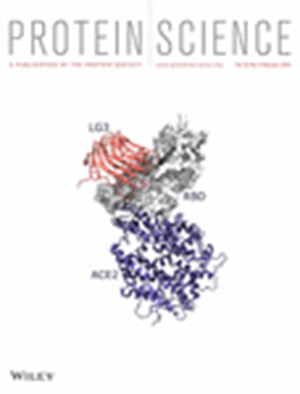低温电子显微镜和固态核磁共振共同提供了更全面的蛋白质纤维结构研究
IF 4.5
3区 生物学
Q1 BIOCHEMISTRY & MOLECULAR BIOLOGY
引用次数: 0
摘要
本研究利用低温电子显微镜(cryo-EM)和固态核磁共振(NMR)联合研究了肌球蛋白 1 同工型 I/C C 端结构域(Tm1-LC)的纤维结构。这项研究证明了这两种结构生物学技术的互补性。固态核磁共振的化学位移分配用于确定单个氨基酸水平上的二级结构,这在低温电子显微镜重建中得到了忠实体现。此外,固态核磁共振还表明,在低温电子显微镜重建密度中未观察到的区域主要处于高度流动的随机线圈构象中,而不是采用多种刚性构象。总之,这项研究说明了结合低温电子显微镜和固态核磁共振研究蛋白质纤维结构的好处。本文章由计算机程序翻译,如有差异,请以英文原文为准。
Cryo‐EM and solid state NMR together provide a more comprehensive structural investigation of protein fibrils
The tropomyosin 1 isoform I/C C‐terminal domain (Tm1‐LC) fibril structure is studied jointly with cryogenic electron microscopy (cryo‐EM) and solid state nuclear magnetic resonance (NMR). This study demonstrates the complementary nature of these two structural biology techniques. Chemical shift assignments from solid state NMR are used to determine the secondary structure at the level of individual amino acids, which is faithfully seen in cryo‐EM reconstructions. Additionally, solid state NMR demonstrates that the region not observed in the reconstructed cryo‐EM density is primarily in a highly mobile random coil conformation rather than adopting multiple rigid conformations. Overall, this study illustrates the benefit of investigations combining cryo‐EM and solid state NMR to investigate protein fibril structure.
求助全文
通过发布文献求助,成功后即可免费获取论文全文。
去求助
来源期刊

Protein Science
生物-生化与分子生物学
CiteScore
12.40
自引率
1.20%
发文量
246
审稿时长
1 months
期刊介绍:
Protein Science, the flagship journal of The Protein Society, is a publication that focuses on advancing fundamental knowledge in the field of protein molecules. The journal welcomes original reports and review articles that contribute to our understanding of protein function, structure, folding, design, and evolution.
Additionally, Protein Science encourages papers that explore the applications of protein science in various areas such as therapeutics, protein-based biomaterials, bionanotechnology, synthetic biology, and bioelectronics.
The journal accepts manuscript submissions in any suitable format for review, with the requirement of converting the manuscript to journal-style format only upon acceptance for publication.
Protein Science is indexed and abstracted in numerous databases, including the Agricultural & Environmental Science Database (ProQuest), Biological Science Database (ProQuest), CAS: Chemical Abstracts Service (ACS), Embase (Elsevier), Health & Medical Collection (ProQuest), Health Research Premium Collection (ProQuest), Materials Science & Engineering Database (ProQuest), MEDLINE/PubMed (NLM), Natural Science Collection (ProQuest), and SciTech Premium Collection (ProQuest).
 求助内容:
求助内容: 应助结果提醒方式:
应助结果提醒方式:


